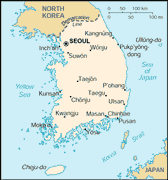National Energy Grid
|
 |
|
Full Size Map National Electricity Transmission Grid of South Korea(23 kb) |
GRID SUMMARY
South Korea uses a combination of thermal (oil,
gas, and coal), nuclear, and hydroelectric capacity
to meet its demand for electric power. Total power
generation capacity was 50 gigawatts (GW) as of
the
beginning of 2000. The South Korean government
estimated in May 2002 that its electricity demand
will rise at an average annual rate of 3.4% per
year through 2015.
While most of South Korea's generating capacity is still controlled by KEPCO, a few independent power producers (IPPs) exist. LG Power, owned by the LG Group conglomerate, operates a 540-megawatt (MW) independent power plant at Bugok near Asan Bay. The facility began operation in April 2001. LG Power purchased the existing Anyang and Puchon plants in June 2000, with a combined capacity of 950 MW, from KEPCO after a competitive tender. Tractebel is also investing in a new 519-MW IPP plant in Yulchon in partnership with Hyundai. In another significant development, South Korea's original IPP, Hanwha Energy was spun off from its chaebol parent company in June 2000, in a deal in which El Paso Energy acquired a 50% stake. Hanwha Energy operates a 1,800-MW plant at Inchon.
While South Korea is not a party to the Kyoto Protocol on greenhouse gas emissions, its future plans emphasize the development of more nuclear power plants to reduce growth in carbon emissions. A dozen additional nuclear plants are planned before 2015.
ENERGY SUMMARY : SOUTH KOREA
Map
of South Korean Electricity Grid | National Energy Grid Index
GENI Home Page | Contact
GENI | Subscribe
to GENI Newsletter | Pledge
| Comments
| GENI Forum
Email this page to a friend
If you speak another language fluently and you liked this page, make
a contribution by translating
it! For additional translations check out FreeTranslation.com
(Voor vertaling van Engels tot Nederlands)
(For oversettelse fra Engelsk til Norsk)
(Для дополнительных
переводов проверяют
FreeTranslation.com )

